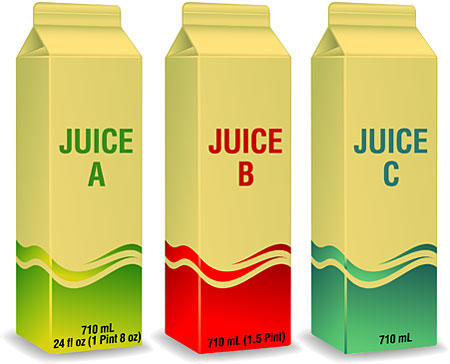
From left to right, cartons A and B feature a dual net quantity of contents statement on the label, as required under the current Fair Packaging and Labeling Act (FPLA). Carton C (far right) features only a metric label, as is recommended by the Uniform Packaging and Labeling Regulation (UPLR), but prohibited by the FPLA. A proposed FPLA amendment would permit U.S. manufacturers to choose either dual or metric labeling for their products.
The National Institute of Standards and Technology (NIST) has issued two publications calling for the amendment of labeling laws to allow the voluntary use of only metric units on some consumer products. NIST researchers suggest that adoption of metric labeling will lead to greater agreement between state and federal labeling laws and simplify domestic and international commerce.
The Fair Packaging and Labeling Act (FPLA) specifies the type of information that must appear on a consumer product label, including the kind of product, name of the manufacturer or responsible party, and net contents. Products that aren't covered by the federal law are regulated by the states, which generally follow the guidance of the Uniform Packaging and Labeling Regulations (UPLR), a publication produced by NIST and the National Conference on Weights and Measures (NCWM). The rules in the UPLR are recommended regulations that only become law if and when adopted by individual states.
In 1992, NIST and the NCWM supported Congress's decision to amend the FPLA to allow manufacturers to label their products with U.S. customary units (inch/pound/pint, etc.) and metric units (centimeter/kilogram/liter, etc.), known as dual unit labeling. Since then, NIST and the NCWM have been working with the states to help them adopt laws that would permit metric only labeling of products under their jurisdiction. Forty-eight states have adopted this approach.
However, some manufacturers worry that the option to label products solely with metric units will confuse consumers and that it will force manufacturers to redesign product packaging.
To allay these concerns, NIST Metric Program coordinator Elizabeth Gentry notes that many products, especially wine and distilled spirits, have been sold with metric-only labels since the early 1980s. A study by her group found that 193 of 1,137 products surveyed in 19 retail stores were labeled with metric units only. More than half of those products were made or distributed by U.S. companies. Moreover, she notes that, under the proposal, use of metric only labeling would be voluntary, as would packaging modifications.
Gentry says there is nothing compelling manufacturers to change package sizing simply because they have the option to use only metric units on their labels. Manufacturers would be free to continue including U.S. customary units (inch/pound/pint, etc.) in the dual unit labeling scheme. The proposed changes to the FPLA would not apply to unit pricing, advertising, recipes, nutrition labeling or other general pricing information.
"We're suggesting these changes to the FPLA in response to requests by U.S. manufacturers and consumers," says Gentry. "Manufacturers want to take control of the limited space on their packaging and giving them the option of using only metric units will offer manufacturers more flexibility."
Download NIST's guide to Voluntary Metric Labeling.
Download NIST's Labeling Marketplace Assessment. (Document no longer available.)

